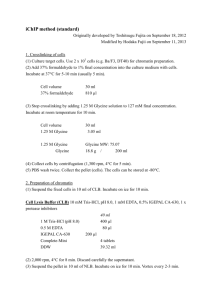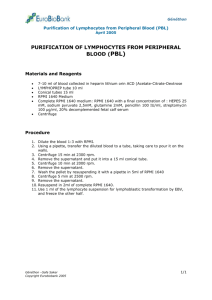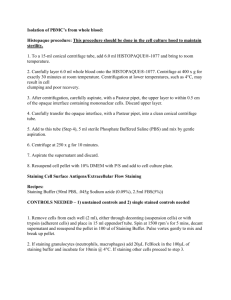iChIP method (standard) 1. Formaldehyde crosslinking of cells (1
advertisement
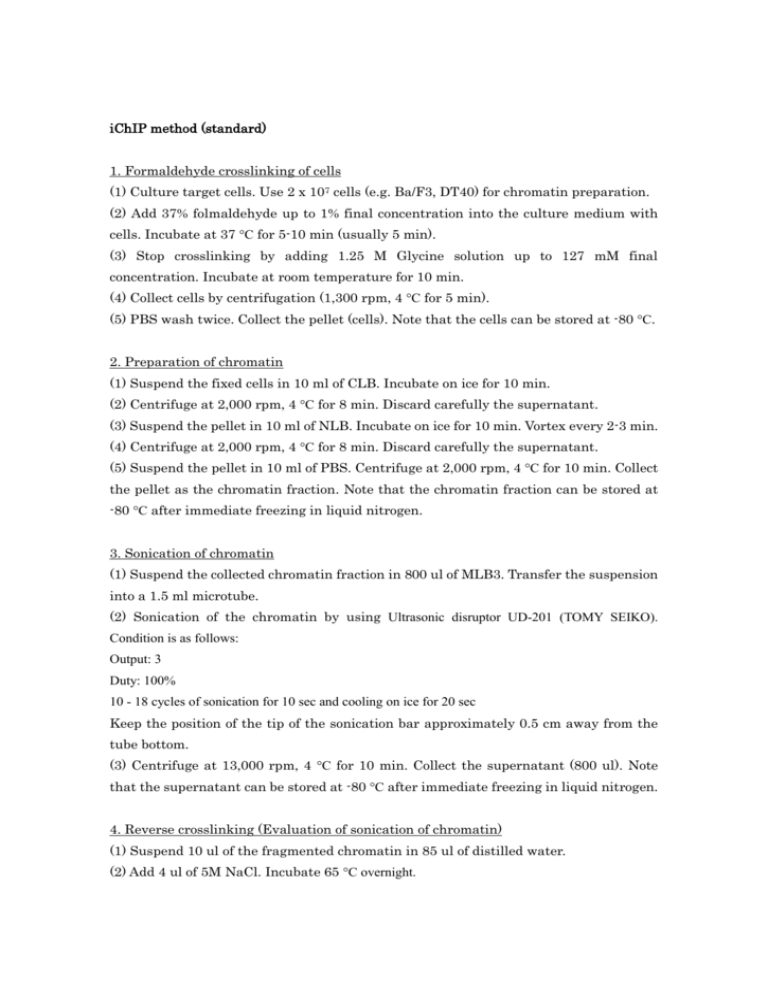
iChIP method (standard) 1. Formaldehyde crosslinking of cells (1) Culture target cells. Use 2 x 107 cells (e.g. Ba/F3, DT40) for chromatin preparation. (2) Add 37% folmaldehyde up to 1% final concentration into the culture medium with cells. Incubate at 37 °C for 5-10 min (usually 5 min). (3) Stop crosslinking by adding 1.25 M Glycine solution up to 127 mM final concentration. Incubate at room temperature for 10 min. (4) Collect cells by centrifugation (1,300 rpm, 4 °C for 5 min). (5) PBS wash twice. Collect the pellet (cells). Note that the cells can be stored at -80 °C. 2. Preparation of chromatin (1) Suspend the fixed cells in 10 ml of CLB. Incubate on ice for 10 min. (2) Centrifuge at 2,000 rpm, 4 °C for 8 min. Discard carefully the supernatant. (3) Suspend the pellet in 10 ml of NLB. Incubate on ice for 10 min. Vortex every 2-3 min. (4) Centrifuge at 2,000 rpm, 4 °C for 8 min. Discard carefully the supernatant. (5) Suspend the pellet in 10 ml of PBS. Centrifuge at 2,000 rpm, 4 °C for 10 min. Collect the pellet as the chromatin fraction. Note that the chromatin fraction can be stored at -80 °C after immediate freezing in liquid nitrogen. 3. Sonication of chromatin (1) Suspend the collected chromatin fraction in 800 ul of MLB3. Transfer the suspension into a 1.5 ml microtube. (2) Sonication of the chromatin by using Ultrasonic disruptor UD-201 (TOMY SEIKO). Condition is as follows: Output: 3 Duty: 100% 10 - 18 cycles of sonication for 10 sec and cooling on ice for 20 sec Keep the position of the tip of the sonication bar approximately 0.5 cm away from the tube bottom. (3) Centrifuge at 13,000 rpm, 4 °C for 10 min. Collect the supernatant (800 ul). Note that the supernatant can be stored at -80 °C after immediate freezing in liquid nitrogen. 4. Reverse crosslinking (Evaluation of sonication of chromatin) (1) Suspend 10 ul of the fragmented chromatin in 85 ul of distilled water. (2) Add 4 ul of 5M NaCl. Incubate 65 °C overnight. (3) Add 1 ul of 10 mg/ml RNase A. Incubate 37 °C for 45 min. (4) Add 2 ul of 0.5M EDTA (pH 8.0), 4 ul of 1M Tris (pH 6.8), and 1 ul of Proteinase K (Roche). Incubate 45 °C for 1.5 h. (5) Pick up 10 ul for electrophoresis in 1% agarose gel without etidium bromide. 100 V for 30 min. (6) Gel staining with etidium bromide or other substitutes for 0.5-1 h. 5. Preparation of Dynabeads conjugated with antibody (1) Transfer 30 ul Dynabeads-protein G (Invitrogen) in a new 1.5 ml tube. (2) Put the tube on a magnet stand and wait for 2 min. Discard the supernatant by pipet. (3) Add 1 ml PBS with 0.01% Tween-20. Put the tube on a magnet stand and wait for 2 min. Discard the supernatant by pipet. (4) Repeat the step (3). (5) Add 300 ul PBS with 0.01% Tween-20 and 0.1% BSA. (6) Add 3 ug antibody (e.g. anti-FLAG antibody Sigma F1804, control IgG). Rotate 4 °C overnight. (7) Centrifuge briefly. Put the tube on a magnet stand and wait for 2 min. Discard the supernatant by pipet. (8) Add 300 ul PBS with 0.01% Tween-20. Invert several times and centrifuge briefly. Put the tube on a magnet stand and wait for 2 min. Discard the supernatant by pipet. (9) Repeat the step (8), twice. The Dynabeads are ready for the next step. 6. Chromatin immunoprecipitation (1) Transfer 160 ul of the fragmented chromatin, which corresponds to chromatin extracted from 4 x 106 cells, into a new 1.5 ml tube. (2) Add 240 ul of MLB3, 50 ul of 10% Triton X-100 (in MLB3), and 50 ul of 10 x protease inhibitor solution (in water). (3) Transfer all (500 ul) of the chromatin solution into the tube, in which the Dynabeads conjugated with control IgG were prepared at the step 5-(9). Rotate 4 °C for 1h. (4) Put the tube on a magnet stand and wait for 2 min. (5) Transfer the supernatant into the tube, in which the Dynabeads conjugated with specific antibody (e.g. FLAG antibody) were prepared at the step 5-(9). Rotate 4 °C overnight. (6) Put the tube on a magnet stand and wait for 2 min. Discard the supernatant using a pipet. (7) Wash 1: Add 1 ml of LSB. Rotate 4 °C for 10 min. Put the tube on a magnet stand and wait for 2 min. Discard the supernatant using a pipet. (8) Wash 2: Repeat the step (7) with HSB instead of LSB. (9) Wash 3: Repeat the step (7) with LiCl buffer instead of LSB. (10) Wash 4: Repeat the step (7) with TE instead of LSB. (11) Add 300 ul of TE and 2 ul of 10 mg/ml RNase A. Incubate at 37 °C for 1h. (12) Add 16 ul of 10% SDS and 10 ul of 20 mg/ml Proteinase K. Incubate at 65 °C overnight. (13) Add 200 ul of TE. Phenol-Chrolofolm extraction with 500 ul Phenol-Chrolofolm solution. Carefully transfer 420 ul of the aqueous layer into a new 1.5 ml tube using a pipet. (14) Chrolofolm extraction with 500 ul Chrolofolm. Carefully transfer 300 ul of the aqueous layer into a new 1.5 ml tube using a pipet. (15) Add 1 ml of 100% ethanol, 50 ul of 3M Sodium acetate, pH 5.2, and 5 ul of 20 mg/mg Glycogen. Store at -20 °C overnight. (16) Centrifuge at 4 °C for 20 min. Decant the supernatant. (17) Add 1 ml of 70% ethanol. Centrifuge at 4 °C for 5 min. Decant the supernatant. (18) Centrifuge briefly and carefully remove the remaining ethanol using a pipet. (19) Suspend the pellet in 50 ul of distilled water. REAGENTS Cell Lysis Buffer (CLB) 10 mM Tris, pH 8.0, 1 mM EDTA, 0.5% IGEPAL CA-630, 1 x protease inhibitors Nuclear Lysis Buffer (NLB) 10 mM Tris, pH 8.0, 1 mM EDTA, 0.5 M NaCl, 1% Triton X-100, 0.5% sodium deoxycholate, 0.5% lauroylsarcosine, 1 x protease inhibitors Modified Lysis Buffer 3 (MLB3) 10 mM Tris, pH 8.0, 1 mM EDTA, 0.5 mM EGTA, 150 mM NaCl, 0.1% sodium deoxycholate, 0.1% SDS, 1 x protease inhibitors Low Salt Buffer (LSB) 20 mM Tris, pH 8.0, 2 mM EDTA, 150 mM NaCl, 1% Triton X-100, 1% SDS High Salt Buffer (HSB) 20 mM Tris, pH 8.0, 2 mM EDTA, 500 mM NaCl, 1% Triton X-100, 1% SDS LiCl Buffer 10 mM Tris, pH 8.0, 1 mM EDTA, 0.25 M LiCl, 0.5% IGEPAL CA-630, 0.5% sodium deoxycholate
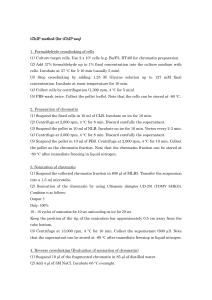
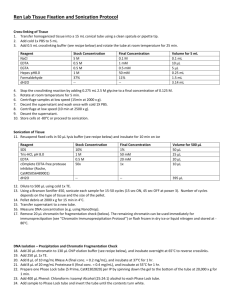
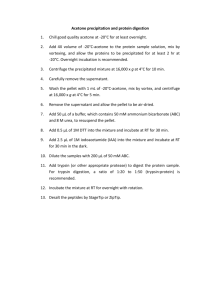
![mRNA Purification Protocol [doc]](http://s3.studylib.net/store/data/006764208_1-98bf6d11a4fd136cb64d21a417b86a59-300x300.png)
